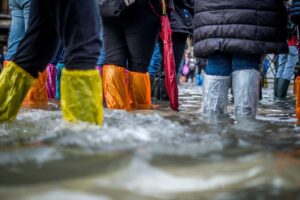Is Cedar Rapids in The Flooding Zone?
Flooding in Cedar Rapids is common, but the floods of 2008 were the most significant event, causing immense damage to the state. The recovery after the flood was a costly affair as the damage to Cedar Rapids was greater than anticipated.
most significant event, causing immense damage to the state. The recovery after the flood was a costly affair as the damage to Cedar Rapids was greater than anticipated.
The flood was due to the Cedar River. Due to global warming, the water levels rose to the highest level in Cedar Rapids history, 31.12 feet. Previously, it only reached 20 feet. The water flooded 14 percent of the city and dislocated more than 18,000 residents.
To prevent fatalities during such disasters, citizens can follow a few safety tips to protect themselves and their family members from the floodwaters and evacuate safely.
Flood Safety Tips
Floods are one of the most dangerous and destructive natural hazards. They can cause power outages, damage infrastructure, trigger landslides, and be deadly to humans and animals. Citizens, especially those belonging to states more prone to flooding, need to be equipped with tips and skills to keep themselves and their families safe before, during, and after a flood.
Here are some safety tips to help you prepare for rising water:
Before a Flood
You need to stay prepared ahead of time for your safety and well-being during this catastrophic event. Here are a few ways you can prepare for a flood:
- Avoid building your home or buying an apartment in a floodplain, especially in a low-lying area and prone to flooding during heavy rains. Look for places on higher grounds and do thorough research, and ask around before making this big of an investment.
- However, if you do live in a floodplain already and there is no other place to move to, call your insurance company and consider buying flood insurance to help with property losses if and when a flood occurs.
- You need to construct barriers or floodwalls to stop floodwater from flowing into your property and damaging all your belongings easily. Sandbags can provide a temporary levee in emergency cases.
- Seal your foundation with waterproof materials, especially the basement, because the chances of floodwater seeping in are the highest there.
- Stay on the lookout for flood warnings and pay attention to weather forecasts. In areas prone to floods, heavy rain and storms can lead to flooding easily.
When a Flood Is Coming
Take these steps after the local authorities and weather forecasts have alerted the citizens about a forthcoming flood:
- Have an emergency plan and practice survival skills with your family. Designate meeting points in case they get lost in the havoc. Also, ensure they know how to swim and disinfect water.
- Assemble an emergency kit for each family member. Include all necessities, such as clothes, water, food, medications, and a first aid kit.
- Charge your cellphones and power banks in case there is a power outage.
- Use battery-operated flashlights and buy extra batteries in case the power outage is prolonged.
- Move all the outdoor furniture indoors and move all expensive belongings to the house’s second floor to save them from floodwater.
- Pay attention to warnings and research about evacuation routes and safe higher places to travel to.
- Turn off the main power switch and disconnect all electrical appliances.
During A Flood
Once the catastrophe has arrived, these steps will help you save the lives of your family and ensure they are safe until the floodwater clears.
- Low-lying areas, such as ditches, basements, or underpasses, become extremely dangerous during a flash flood, and that is why it is best to avoid them.
- Find dry areas to walk in; walking in flooded areas could be dangerous as you never know how deep the water is and what lies underneath it that could hurt you.
- If you have no choice but to walk in areas covered with water, try to walk where the water is not moving. Use a stick to check how deep the water is and the firmness of the ground in front of you.
- Do not try to drive in floodwaters. Sadly, if water rises above your car, you will have to abandon the car and move to higher ground.
- Touching electrical equipment with wet hands can be dangerous. Make sure you’re not in the water when using one.
After A Flood
- Once the floodwaters have passed, wait for the authority’s instructions before you try to return to your home. Return to your place only when the authorities say it is safe.
- Listen to news reports carefully and note down the places where water is hygienic and clean to drink.
- Drowned power lines are dangerous, so it is best to avoid them and report them to the power company.
Call 911 Restoration
Carson City is known to have floods annually. 911 Restoration has specialized equipment and years of experience to help in flood emergencies in cases of disaster and water damage to properties. If you’re looking for a Restoration Company in Cedar Rapids, our services are available 24/7, and in case of emergencies, we cater to your needs within 45 minutes. Call us now at (319) 302-3078!



